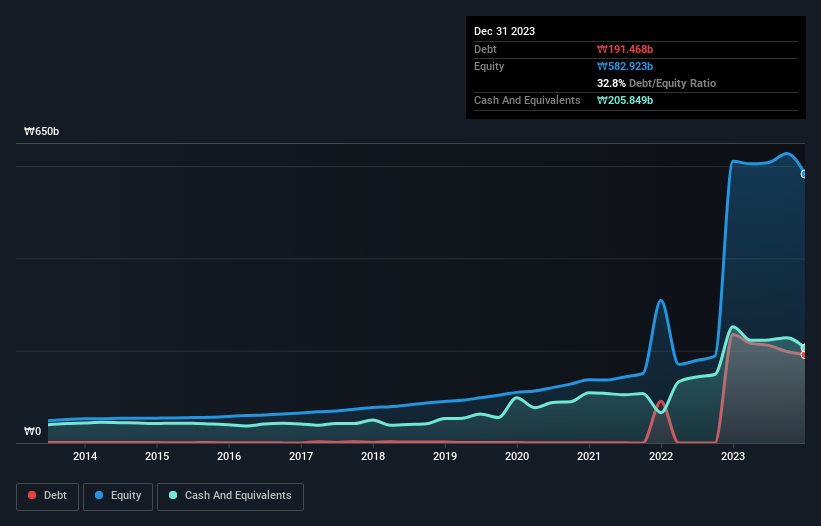- South Korea
- /
- Interactive Media and Services
- /
- KOSDAQ:A119860
We Think Connectwave (KOSDAQ:119860) Can Stay On Top Of Its Debt

Warren Buffett famously said, 'Volatility is far from synonymous with risk.' It's only natural to consider a company's balance sheet when you examine how risky it is, since debt is often involved when a business collapses. As with many other companies Connectwave Co., Ltd. (KOSDAQ:119860) makes use of debt. But the more important question is: how much risk is that debt creating?
Why Does Debt Bring Risk?
Debt and other liabilities become risky for a business when it cannot easily fulfill those obligations, either with free cash flow or by raising capital at an attractive price. Part and parcel of capitalism is the process of 'creative destruction' where failed businesses are mercilessly liquidated by their bankers. However, a more frequent (but still costly) occurrence is where a company must issue shares at bargain-basement prices, permanently diluting shareholders, just to shore up its balance sheet. Of course, debt can be an important tool in businesses, particularly capital heavy businesses. The first step when considering a company's debt levels is to consider its cash and debt together.
See our latest analysis for Connectwave
How Much Debt Does Connectwave Carry?
The image below, which you can click on for greater detail, shows that Connectwave had debt of ₩191.5b at the end of December 2023, a reduction from ₩234.9b over a year. However, it does have ₩205.8b in cash offsetting this, leading to net cash of ₩14.4b.

How Healthy Is Connectwave's Balance Sheet?
According to the last reported balance sheet, Connectwave had liabilities of ₩90.9b due within 12 months, and liabilities of ₩213.6b due beyond 12 months. Offsetting these obligations, it had cash of ₩205.8b as well as receivables valued at ₩40.3b due within 12 months. So it has liabilities totalling ₩58.3b more than its cash and near-term receivables, combined.
Since publicly traded Connectwave shares are worth a total of ₩619.3b, it seems unlikely that this level of liabilities would be a major threat. However, we do think it is worth keeping an eye on its balance sheet strength, as it may change over time. While it does have liabilities worth noting, Connectwave also has more cash than debt, so we're pretty confident it can manage its debt safely.
One way Connectwave could vanquish its debt would be if it stops borrowing more but continues to grow EBIT at around 13%, as it did over the last year. When analysing debt levels, the balance sheet is the obvious place to start. But it is Connectwave's earnings that will influence how the balance sheet holds up in the future. So if you're keen to discover more about its earnings, it might be worth checking out this graph of its long term earnings trend.
But our final consideration is also important, because a company cannot pay debt with paper profits; it needs cold hard cash. Connectwave may have net cash on the balance sheet, but it is still interesting to look at how well the business converts its earnings before interest and tax (EBIT) to free cash flow, because that will influence both its need for, and its capacity to manage debt. Over the last three years, Connectwave actually produced more free cash flow than EBIT. That sort of strong cash generation warms our hearts like a puppy in a bumblebee suit.
Summing Up
We could understand if investors are concerned about Connectwave's liabilities, but we can be reassured by the fact it has has net cash of ₩14.4b. And it impressed us with free cash flow of ₩28b, being 118% of its EBIT. So we don't think Connectwave's use of debt is risky. The balance sheet is clearly the area to focus on when you are analysing debt. However, not all investment risk resides within the balance sheet - far from it. For example Connectwave has 4 warning signs (and 1 which doesn't sit too well with us) we think you should know about.
If, after all that, you're more interested in a fast growing company with a rock-solid balance sheet, then check out our list of net cash growth stocks without delay.
New: AI Stock Screener & Alerts
Our new AI Stock Screener scans the market every day to uncover opportunities.
• Dividend Powerhouses (3%+ Yield)
• Undervalued Small Caps with Insider Buying
• High growth Tech and AI Companies
Or build your own from over 50 metrics.
Have feedback on this article? Concerned about the content? Get in touch with us directly. Alternatively, email editorial-team (at) simplywallst.com.
This article by Simply Wall St is general in nature. We provide commentary based on historical data and analyst forecasts only using an unbiased methodology and our articles are not intended to be financial advice. It does not constitute a recommendation to buy or sell any stock, and does not take account of your objectives, or your financial situation. We aim to bring you long-term focused analysis driven by fundamental data. Note that our analysis may not factor in the latest price-sensitive company announcements or qualitative material. Simply Wall St has no position in any stocks mentioned.
About KOSDAQ:A119860
Mediocre balance sheet low.
Market Insights
Community Narratives



